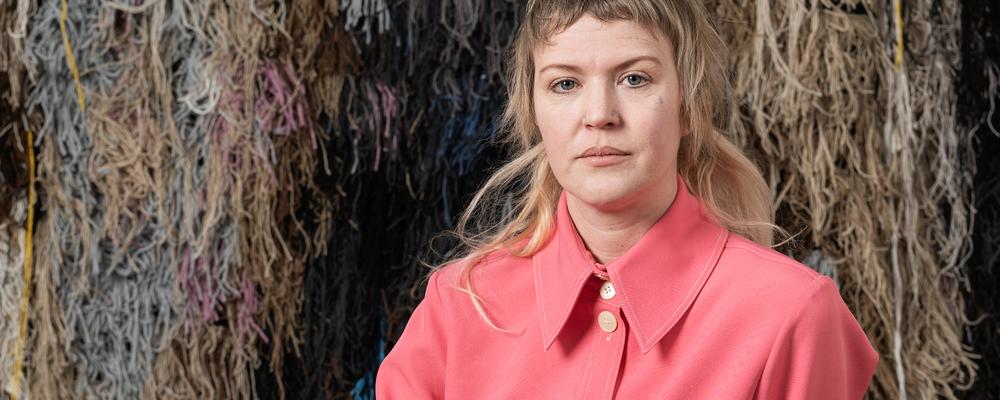
- Home
- News and events
- Find news
- 5 questions to Emelie Röndahl before the public defense on September 28
5 questions to Emelie Röndahl before the public defense on September 28
Presenting Emelie Röndahl, doctoral student in crafts who on September 28 will present her thesis at Röhsska muséet. We sent Emelie a couple of questions in order to get to know her motivations and research process a bit better before the big day.
1. How would you describe your research (and dissertation Crying Rya: a practitioner's narrative through handweaving)?
My research offers an example of perspectives and insights from inside of an individual practice – my own. I have tried to put this practice into context. The artist’s perspective, particularly in crafts, is still rather unusual. Our practice is usually explained by theorists and historians, who in most cases lack practical experience and corporeal knowledge. This contributes to the propagation of myths and stereotypes. One example is the notion that weaving is a ‘slow medium’. If you ask me, the truth is not so simple, nor is that notion particularly interesting.
2. What made you choose this topic, this focus?
I became fascinated with rya weaving in 2014, and I’ve been fascinated by it ever since. I’ve had many exhibitions both in Sweden and abroad, but I’ve always gotten the same kind of questions wherever I go: how long does it take? That question has been a trigger for me, and it made me wonder why I kept running into it over and over again. I realised much later that I was contributing to that kind of question myself. I was defensive and irritated, and so I brought it up myself sometimes before I was even asked the question, just to be done with it. That didn’t lead anywhere. At the same time, I had a different question inside me: where does the image originate? My fascination with the technique and expression of ryas comes from their built-in two-sidedness – that their two sides are so different visually. An image of a smiling child on one side becomes grotesque and miserable on the hairy reverse.
3. What has the process been like? How did you conduct your research?
From most perspectives, the process has been artistic and self-critical. I wove, I read and I wrote. There were a number of shifts that I think were pivotal. For example, when I realised that I had been describing my own practice as ‘slow’, and when on one occasion I outsourced my weaving to an assistant (due to pregnancy and an impending deadline), which led to the insight that it was impossible for me to work like that. Within the concept of collaboration, there are a lot of different aspects to consider. I realised that I did not want to collaborate on the practical making, and I guess I still don’t want to. One change in my writing method that has been pivotal came during an extended period of sick leave, during the pandemic, when I started drawing and painting – nonsense at first, but later it developed into a way of describing thoughts and knowledge through making – things I couldn’t get hold of through words alone. Later I was able to develop those drawings into arguments and essays. In that way, I could find my own artistic voice – a voice that was less influenced by what had already been written.
4. What would you say is your conclusion?
‘Conclusion’ assumes that I have a question to answer, a problem to solve. And one of many conclusions is that my earlier questions were incorrectly formulated. I was relating to what had been formulated by people who have no bodily experience (curators, journalists, theorists, historians). My conclusion is probably also that maybe we shouldn’t always believe in the words we’ve been using to describe our own practice – because how much have we borrowed without double-checking whether it’s confirmed by our own experience? I have been sceptical of artistic research, even when I was in the midst of it myself. Now I know that it has made me a better artist, because it demystified a lot for me. Before then, I didn’t have a method or an approach that I could identify; I just got on with it. My risk-taking has increased as a result of my doctoral studies, and that is one of the most important components in any artistic practice.
To the question of ‘how long it takes’ or the assertion that ‘weaving is a slow medium’, my simple conclusion is that these notions exclude the weaving body. That is something I believe can be applied to other hand-making practices as well.
And how does the exhibition relate to your dissertation?
The exhibition is the framework for my dissertation. All of my work is a foundation for the whole PhD effort. I would not have written if I hadn’t woven – I can’t think if I don’t weave. And I can add that as soon as I had finished writing and put that behind me, I immediately continued with my weaving. The term ‘practice-led research’ is quite prevalent among us at HDK-Valand. And I used that term myself in the beginning. But not anymore. It feels wrong to say that my dissertation came about through a practice-led method; it’s really just the practice, and the formulating and the exploration of that practice, that are my focus. More than anything, the doctoral programme has made me a better artist, not turned me into an academic.
